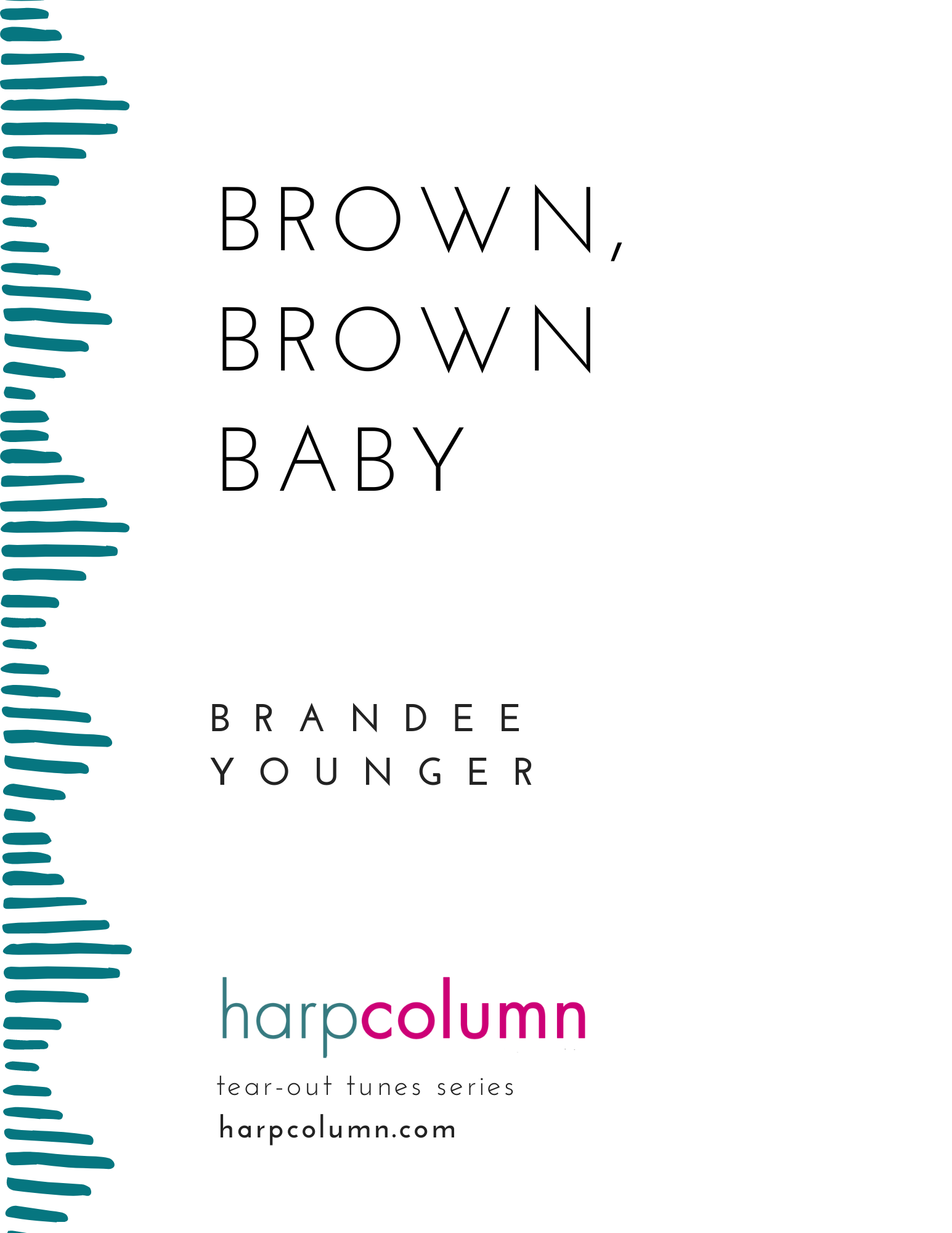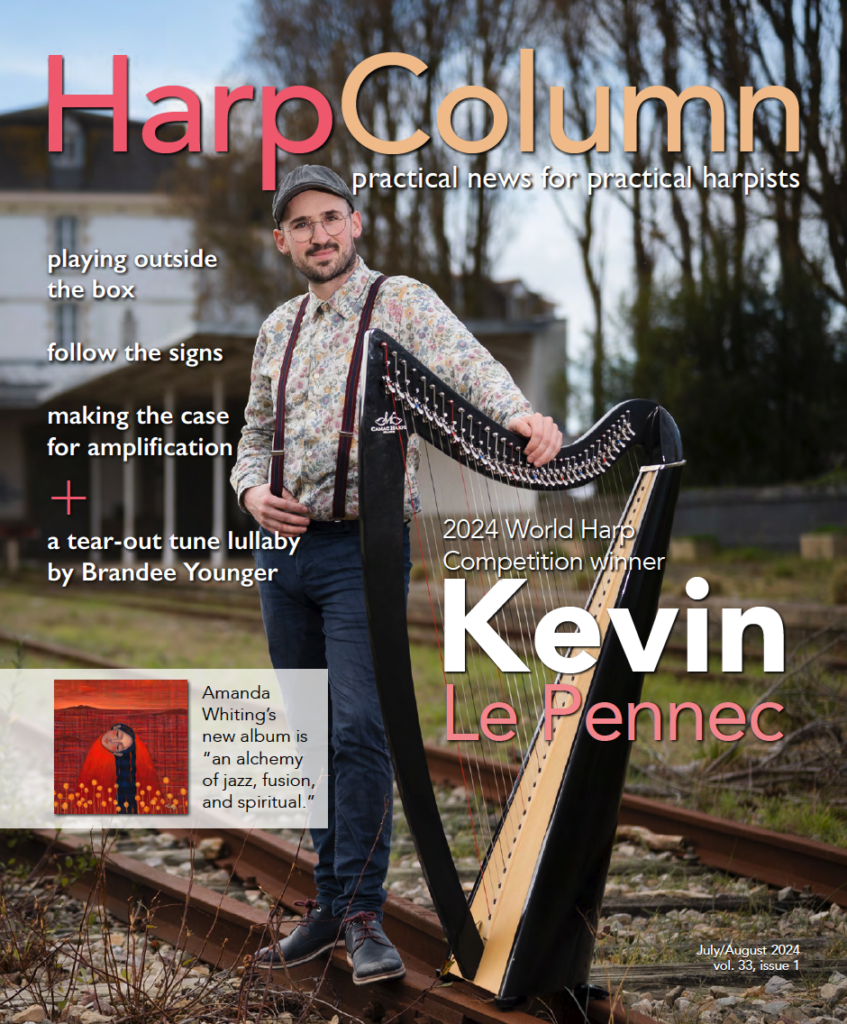
Download this issue to get this tune now!
Each installment of our Tear-Out Tunes series features a new piece written by one of the best harpist-composer-arrangers in the business. Each composer will tell you a little bit about their piece, and also give you some helpful tips for learning it and getting the most out of the experience. The new piece (on the following pages) is yours to keep. We even put it right in the middle of the magazine so you can tear out the whole sheet and put your new tune on your music stand.
Shortly before taking an educational retreat to St. Elizabeth, Jamaica, I decided to bring my small, 26-string Harpsicle along with me. While on the island visiting elementary schools, my friend/colleague and I took a little self-care time on Treasure Beach. There, she handed me a poem that she titled “Brown, Brown Baby.” It was a beautiful poem that she wanted set to music as a lullaby. After reading it aloud a couple of times, I started to sing the words and was quickly able to hear what it could sound like as a melody. It may be a sign of the times, but I pulled out my phone and used the Voice Memos app to document it all. I heard it in four-bar phrases:
Brown, Brown Baby skin so sweet
Tastes like a cup of honey bush tea
The sun loved you before you were born
Now sleep like the sun ’til the early morn…
My friend who authored the poem is a mother of three energetic children who owns and runs a couple of preschools, so the need for a soothing lullaby was really important to her. I could just imagine her lulling her own little ones and preschool students to sleep with this.
Make it memorable—create an earworm
Since this was intended to be a lullaby, I thought about the characteristics that would promote relaxation. I created a simple and repetitive figure that was memorable, with very slight harmonic or melodic variations at the ends of the small phrases. At the end of each larger, eight-bar phrase, I felt a natural fermata. Maybe at the end of the larger phrases, there’s a chance that the baby has fallen asleep, so it’s just enough time to pause and look to see if the song can end. I wasn’t sure if full-on fermatas were too much, so I decided to make them molto ritardandos, hoping that felt and sounded more natural. It’s a melody that can be repeated endless times. Actually, I recently recorded it for World Sleep Day and had to shorten it because the melody was “stated too many times” according to the streaming team at my record label. This sheet music reflects the edited version.
No accidentals & choosing the range
Since I composed this on a Harpsicle and was sitting in a less-than-ideal position, changing key wasn’t an option. Also, being limited to a 26-string range influenced where I ultimately decided to notate and record it, which is primarily in the upper two-thirds of a pedal harp’s range. There are a couple of places where the bass reaches the fifth-octave B, but there is nothing composed lower than that. This makes it playable on nearly any harp, and that low B can be played up an octave for smaller harps.
Comfort for the hand
I really wanted everything to fit nicely into the hands, and that was pretty well accomplished, with few exceptions. Bar 16 was a bit awkward to play on the second and third beats without buzzing, so I had to experiment with it to find a decent fingering. I do not put fingerings in my sheet music partly because my Finale skills are limited, but also because everyone uses such different fingerings, and I find that many of my colleagues prefer to use their own.
My biggest challenge
Dynamics were really a challenge for me. On the 26-string harp, I had no choice but to lighten up my touch and play softly. However, playing this on a pedal harp with much tighter tension forced me to take a step back and assess my sound. I am a pretty loud player, so playing quietly while maintaining a rich tone was quite tough. As much as I wanted to play loudly, I kept reminding myself that it is a lullaby, and the intent is to be mellow and encourage dozing off.
Be yourself
Though this short composition is fully notated, it’s important to know you can be yourself when you play it. The chord structure is simple enough to create your own left-hand accompaniment, and the melody can be improvised openly. The piece consists of mainly B-flat, F, and E-flat major chords and a G minor chord. It’s fun to play around with different inversions of those chords to hear how they change the sound. It’s also a good practice to substitute some of the bass notes. Since it’s all diatonic, there are so many options to explore without ever sounding too out of bounds. Overall, the idea is to keep the feeling and spirit of a lullaby in mind while making it your own.
I truly hope that this short, easy tune brings some joy to those who play it and some rest to those who listen to it. •







